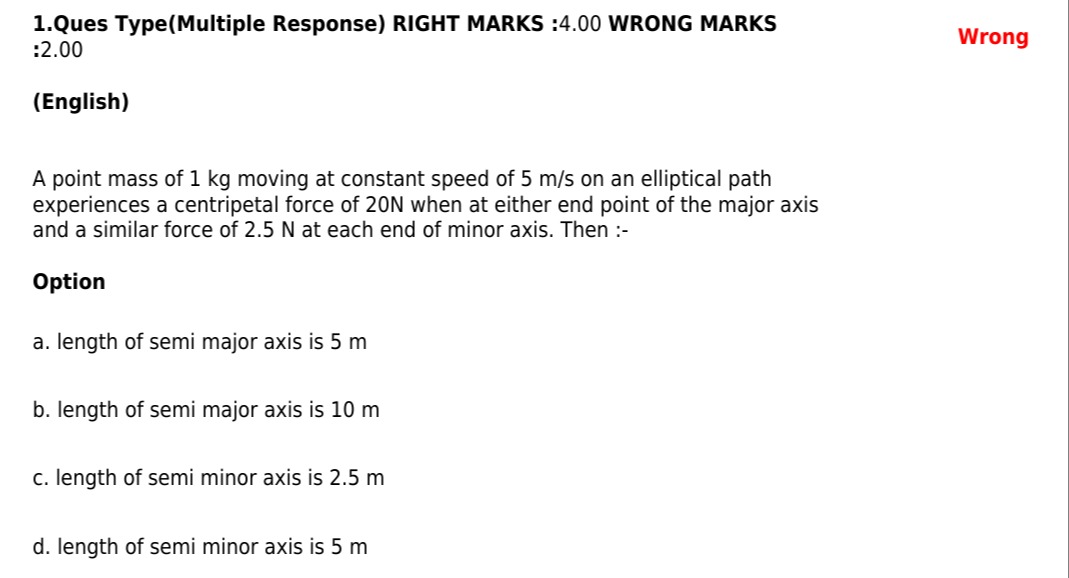Question
Question: A point mass of 1 kg moving at constant speed of 5 m/s on an elliptical path experiences a centripet...
A point mass of 1 kg moving at constant speed of 5 m/s on an elliptical path experiences a centripetal force of 20N when at either end point of the major axis and a similar force of 2.5 N at each end of minor axis. Then :-

length of semi major axis is 5 m
length of semi major axis is 10 m
length of semi minor axis is 2.5 m
length of semi minor axis is 5 m
a, c
Solution
The problem describes a point mass moving on an elliptical path at a constant speed. We are given the mass of the object, its speed, and the centripetal force it experiences at the endpoints of the major and minor axes.
Let the mass of the object be m=1 kg.
Let the constant speed of the object be v=5 m/s.
Let the length of the semi-major axis be a and the length of the semi-minor axis be b.
The centripetal force Fc experienced by an object moving in a curved path with radius of curvature R and speed v is given by Fc=Rmv2.
At the endpoints of the major axis, the radius of curvature is Ra=ab2. The centripetal force at these points is given as Fa=20 N.
So, Fa=Ramv2=b2/amv2=b2mv2a.
Substituting the given values, we have 20=b2(1)(52)a=b225a.
This gives the equation 20b2=25a, which simplifies to 4b2=5a (Equation 1).
At the endpoints of the minor axis, the radius of curvature is Rb=ba2. The centripetal force at these points is given as Fb=2.5 N.
So, Fb=Rbmv2=a2/bmv2=a2mv2b.
Substituting the given values, we have 2.5=a2(1)(52)b=a225b.
Multiplying by 4, we get 10=a2100b, or 10a2=100b, which simplifies to a2=10b (Equation 2).
Now we solve the system of equations:
- 4b2=5a
- a2=10b
From Equation 2, we can express b in terms of a: b=10a2.
Substitute this expression for b into Equation 1:
4(10a2)2=5a
4100a4=5a
25a4=5a
a4=125a
a4−125a=0
a(a3−125)=0
Since a is the length of the semi-major axis, a>0. Thus, we can divide by a:
a3−125=0
a3=125
a=3125=5.
So, the length of the semi-major axis is a=5 m.
Now substitute the value of a back into the expression for b:
b=10a2=1052=1025=2.5.
So, the length of the semi-minor axis is b=2.5 m.
Let's check the given options:
a. length of semi major axis is 5 m (Matches our result)
b. length of semi major axis is 10 m (Does not match)
c. length of semi minor axis is 2.5 m (Matches our result)
d. length of semi minor axis is 5 m (Does not match)
Based on our calculations, both option a and option c are correct.
